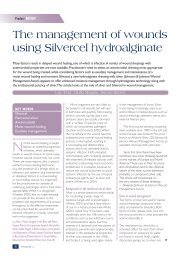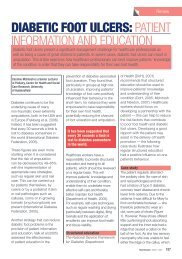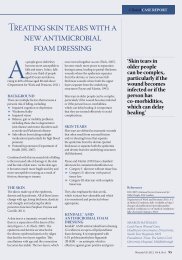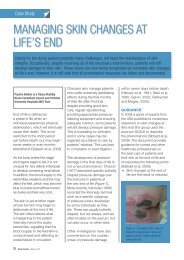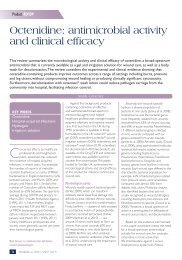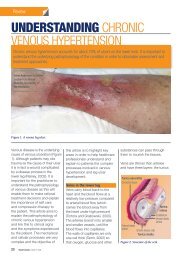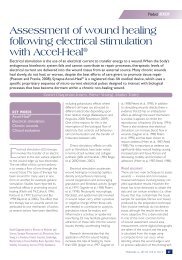Are pressure ulcer grading & risk assessment tools useful?
Are pressure ulcer grading & risk assessment tools useful?
Are pressure ulcer grading & risk assessment tools useful?
Create successful ePaper yourself
Turn your PDF publications into a flip-book with our unique Google optimized e-Paper software.
Clinical REVIEW<br />
Key Points<br />
8 Currently there is no superior<br />
alternative to the <strong>risk</strong><br />
<strong>assessment</strong> and classification/<br />
<strong>grading</strong> <strong>tools</strong> that are widely<br />
used in clincial practice.<br />
8 Despite a paucity of research<br />
available to endorse them, both<br />
<strong>tools</strong> are still recommended<br />
for use during the <strong>assessment</strong><br />
process.<br />
8 If used appropriately, both <strong>tools</strong><br />
have the potential to enhance<br />
patient care.<br />
European Pressure Ulcer Advisory Panel<br />
(EPUAP) <strong>grading</strong> tool<br />
The experts who constitute the EPUAP<br />
have now reached a consensus of<br />
opinion and recommend the use of the<br />
EPUAP Guide to Pressure Ulcer Grading<br />
(EPUAP, 2003). This tool is a modified<br />
version of the National Pressure Ulcer<br />
Advisory Panel (NPUAP) classification<br />
tool, in which some of the descriptions<br />
have been altered, and where stages<br />
have been re-named as grades. Like<br />
the SPSSS scale, the EPUAP <strong>grading</strong><br />
tool has four grades with non-blanching<br />
erythema regarded as a grade 1<br />
<strong>pressure</strong> <strong>ulcer</strong>. Furthermore, the<br />
EPUAP <strong>grading</strong> tool also describes some<br />
warning signs that may be evident in an<br />
individual with pigmented skin, which<br />
has not previously been addressed.<br />
What is the best <strong>grading</strong>/classification tool?<br />
Like <strong>pressure</strong> <strong>ulcer</strong> <strong>risk</strong> <strong>assessment</strong> <strong>tools</strong>,<br />
there is a dearth of research available<br />
to endorse one particular classification<br />
tool, although the EPUAP do now<br />
recommend the use of the EPUAP<br />
Guide to Pressure Ulcer Grading Tool<br />
(EPUAP, 2003). Unlike <strong>pressure</strong> <strong>ulcer</strong> <strong>risk</strong><br />
<strong>assessment</strong> <strong>tools</strong>, where the predictive<br />
validity was an important factor when<br />
reviewing the research, it is more<br />
important to assess inter-rater reliability<br />
with classification/<strong>grading</strong> <strong>tools</strong>. This<br />
is because classification/<strong>grading</strong> <strong>tools</strong><br />
are constructed in a similar manner,<br />
therefore, it is important to establish<br />
that when different practitioners use the<br />
tool to assess a wound, that they will<br />
reach a similar conclusion.<br />
There are three main pieces of<br />
research assessing inter-rater reliability<br />
of <strong>pressure</strong> <strong>ulcer</strong> classification/<strong>grading</strong><br />
<strong>tools</strong>. The method of investigation in<br />
each of the studies relied on either the<br />
use of photographs, or visual inspection<br />
of skin, to test the practitioner’s ability<br />
to grade <strong>ulcer</strong>s accurately. In 1996,<br />
Healey found that the increased<br />
descriptions within the Stirling (SPSSS)<br />
tool had the reverse effect than what<br />
the authors had anticipated, and actually<br />
reduced the levels of agreement<br />
between staff. Bours et al (1999)<br />
noted that there was a higher level of<br />
agreement when practitioners had the<br />
opportunity to discuss EPUAP <strong>grading</strong><br />
as a group, in comparison to scoring<br />
<strong>pressure</strong> <strong>ulcer</strong>s independently. Defloor<br />
and Schoonhoven (2004) suggested<br />
that there was a high level of inter-rater<br />
reliability among experts when using<br />
the EPUAP classification tool. However,<br />
there was difficulty in distinguishing<br />
between incontinence lesions, blisters<br />
and superficial <strong>pressure</strong> <strong>ulcer</strong>s.<br />
All of the studies above used the<br />
Kappa’s co-efficient statistical test to<br />
analyse their results. However, critics<br />
have intimated that the Kappa’s<br />
statistical test may not be the most<br />
reliable, raising questions about the<br />
results of these studies (Defloor and<br />
Schoonhoven, 2004). Would another<br />
statistical test show the results of these<br />
studies in a more or less favourable<br />
light? Once again, to answer this<br />
question, further research is required to<br />
establish a true picture of the efficacy of<br />
these classification <strong>tools</strong>.<br />
Guidance when using classification <strong>tools</strong><br />
Like <strong>risk</strong> <strong>assessment</strong> <strong>tools</strong>, <strong>pressure</strong> <strong>ulcer</strong><br />
classification/<strong>grading</strong> <strong>tools</strong> are regarded<br />
as important implements to help grade<br />
the extent of <strong>pressure</strong> damage and<br />
form an integral part of the nursing<br />
documentation and wound <strong>assessment</strong>.<br />
However, for the <strong>assessment</strong> to be<br />
accurate, practitioners need be educated<br />
on how to use the <strong>tools</strong>. Looking at the<br />
larger picture, it would be beneficial if<br />
one tool was adopted at a national level<br />
to ascertain if the incidence and grade of<br />
<strong>pressure</strong> <strong>ulcer</strong>s is increasing or decreasing<br />
(EPUAP, 1998). Finally, it is important that<br />
<strong>pressure</strong> <strong>ulcer</strong> classification/<strong>grading</strong> <strong>tools</strong><br />
are not used by practitioners to reverse<br />
grade healing <strong>ulcer</strong>s, because wound<br />
healing is not simply the reverse sequence<br />
of repairing tissue that ensued from<br />
<strong>pressure</strong> <strong>ulcer</strong>ation (Clark, 2005).<br />
Conclusion<br />
Currently there is no superior alternative<br />
to the <strong>pressure</strong> <strong>ulcer</strong> <strong>risk</strong> <strong>assessment</strong> and<br />
classification/<strong>grading</strong> <strong>tools</strong> that are widely<br />
used in clinical practice. Despite a lack<br />
of consistent robust research, both <strong>tools</strong><br />
are still recommended for use during the<br />
<strong>assessment</strong> process. Essentially, if used<br />
appropriately, both types of tool have the<br />
potential to enhance patient care, through<br />
early implementation of preventative or<br />
management strategies, to prevent or<br />
minimise further <strong>pressure</strong> damage. WUK<br />
References<br />
Barnes D, Payton RG (1993) Clinical<br />
Application of the Braden Scale in the Acutecare<br />
Setting. Dermatol Nurs 5(5): 386–8<br />
Bates-Jensen B (2001) Quality indicators for<br />
prevention and management of <strong>pressure</strong> <strong>ulcer</strong>s<br />
in vulnerable elders. Ann Intern Med 135(8):<br />
744–50<br />
Bergstrom N, Braden BJ, Laguzza A, Holman<br />
V (1987) The Braden Scale for Predicting<br />
Pressure Sore Risk. Nurs Res 36(4): 205–210<br />
Bergstrom N, Demuth PJ, Braden BJ (1987) A<br />
Clinical trial of the Braden Scale for Predicting<br />
Pressure Sore Risk. Nurs Clin N Am 22(2): 417–28<br />
Best Practice Statement (2002) Pressure Ulcer<br />
Prevention (2002). Available from: www.<br />
nhshealthquality.org<br />
Best Practice Statement (2002) Nutrition:<br />
<strong>assessment</strong> and referral in the care of adults in<br />
hospital. Available from: www.nhshealthquality.org<br />
Bethell E (2003) Controversies in classifying<br />
and assessing grade 1 <strong>pressure</strong> <strong>ulcer</strong>s. J Wound<br />
Care 12(1): 33–6<br />
Bliss MR (1998) Hyperaemia. J Tissue Viability<br />
8(4): 4–13<br />
Bours GJ, Halfens RJ, Lubbers M, Haalboom<br />
JR (1999) The development of a national<br />
registration form to measure the prevalence<br />
of <strong>pressure</strong> <strong>ulcer</strong>s in the Netherlands. Ostomy/<br />
Wound Management 45: 28–40<br />
Braden BJ, Bergstrom N (1994) Predictive<br />
Validity of the Braden Scale for <strong>pressure</strong> sore <strong>risk</strong><br />
in a nursing home. Res Nurs Health 17: 459–70<br />
Bridel J (1994) Risk <strong>assessment</strong>. J Tissue<br />
Viability 4(3): 84–5<br />
68 Wounds UK



